In the second half of March, I traveled to India (Bangalore,
Delhi, and Pune) to speak at TechEd India and TechDays Delhi about
Windows 8 app development.
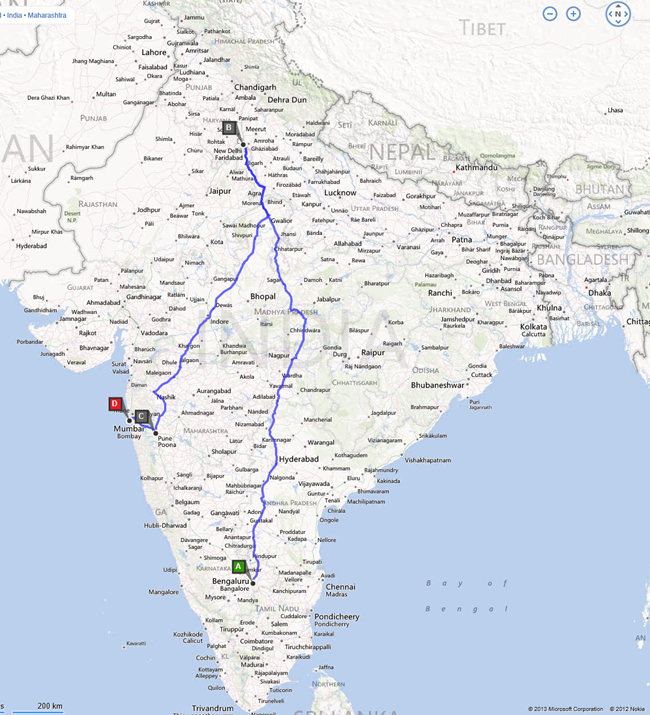
I flew from Dulles International in VA to Charles De Gaulle in
France, where I met up with my colleague Nisha Singh, who had flown
from Seattle. From there, we flew Air France to Bangalore for
TechEd India Bangalore, then hopped a Jet Airways flight to New
Delhi for TechDays Delhi. While there, I took a car to Agra over
the weekend (more on that shortly). Then another Jet Airways flight
from Delhi to Pune for TechEd India Pune. And finally, a short
flight from Pune to Mumbai before the 16 1/2 hour flight from
Mumbai to Newark NJ, and the prop plane from Newark to Dulles.
What I had expected
Before I went away to India, my only experience with developers
in India was the lowest-price outsourcing companies I often had to
clean up after as a consultant, the outsourced call center tech
support folks I'll sell a kidney to avoid, and the numerous "send
me the codes" emails I get. So, I had some pre-conceived notions as
to what to expect from the developer community.
I'm happy to say I was completely wrong.
The developer community in India is strong,
professional, and enthusiastic. The people I met at TechEd
India were serious developers, building awesome apps and the usual
bevvy of line of business apps internal to companies. The developer
community in Pune, for example, is huge. The Pune .NET user group
community (PUG) has membership in the mid 4 digits. Yep. That's
pretty big. I was lucky to have been able to meet with the leads
(my flight was delayed, so I arrived at the hotel just in
time.)
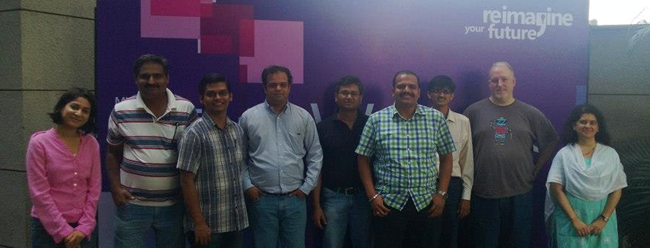
Photo by Vikram Pendse
TechEd and TechDays
TechEd India covered Bangalore and Pune. TechDays India happened
in Delhi in between the two.
These events are smaller than TechEd US and TechEd Europe, but
the production values are just as high, with even a few extras
thrown in. A couple years ago, a monkey snuck in the back door of
an event hall and perched on top of the screen, watching the demos.
The original code monkey :)
Here's the keynote hall for TechEd Bangalore. This was located
in an outside stand-alone building.
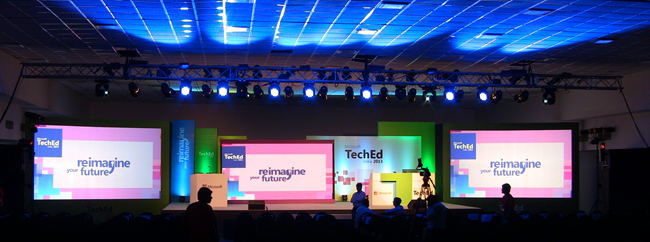
TechEd Pune was even larger, located inside a hotel: the JW
Marriott Pune. Here's Nisha presenting to a full house:
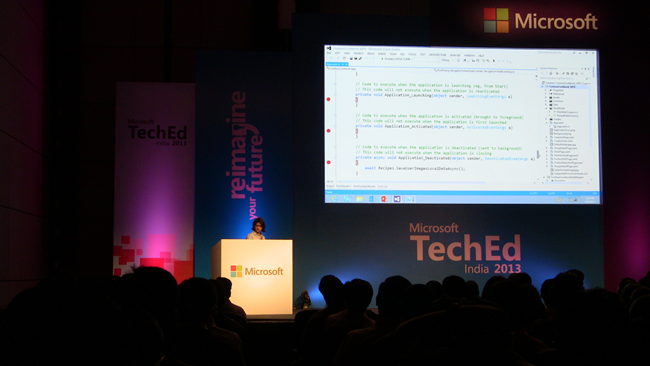
I think this was from my talk on XAML performance. I must have
been explaining something pretty serious when this photo was taken
:)
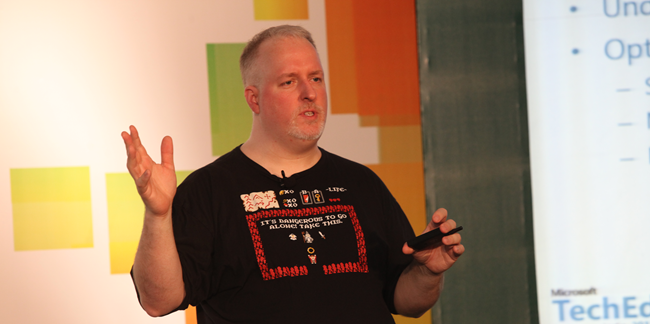
(This photo from Bangalore was shared to me without
attribution. If you are the photographer, please let me
know.)
The "Stump the Speaker" panels were my favorite part. In this
photo, from Bangalore, I had so much Q&A at the end of my
session, I arrived late to the panel, and got the honorary tall
seat.
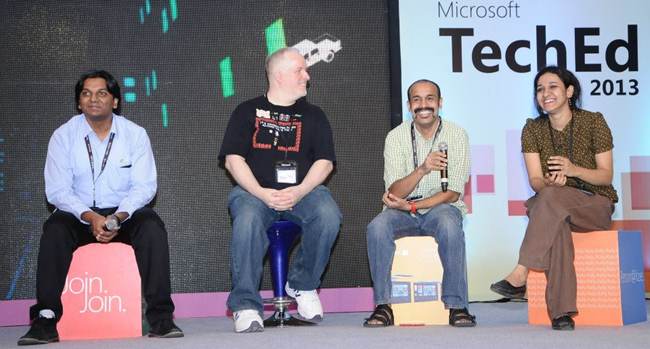
Photograph by Microsoft, India
TechDays Delhi was a free event, so it attracted a lot of local
students. I was pleased to speak with this audience, as getting our
tools, and our guidance on quality apps in front of them is really
important. Students are responsible for some of the most exciting
startups and some of the coolest apps.
Finally, one thing that I thought was done extremely well at
TechEd India was the keynote by four children. Take a moment and
watch it now.
The must-see
demo from TechEd India
My session decks for the TechEd events are available here: https://india.msteched.com/
Click on "downloads" at the top right. My three sessions were:
- Addressing Performance in Windows 8 XAML apps (day 1, architect
track)
- Tips and Techniques for Building High Quality Windows 8 apps
(day 2, Windows 8 track)
- Smoothly Navigating the Windows Store Submission,
Certification, and Listing Process (day 2, Windows 8 track)
Recordings will be up soon, as I understand it. I'd recommend
watching Bangalore, as Pune had to squeeze sessions to account for
keynote overrun, so the sessions are a bit compressed.
PCs and phones: an observation
Here are some interesting observations about PCs, phones, and
tablets in India:
- Almost all developers have a smart phone
- iPhone is not the number one smart phone, or even the number
two smart phone in India, despite their advertising there.
-
Look who's doing well in India and more recent news
here
- I saw only a single iPhone at the events, and not a single
iPad. This includes the event the students attended.
- Total phone ownership is approximately 12x any sort of PC or
Mac ownership
- For car drivers and non-IT folks, that little indestructible
Nokia was what I usually saw. Feature phones still dominate in
India.
- I saw a number of high end Android tablets and some Surface w/
Windows RT
This data all came from the local folks and my personal
observations, so use it only as anecdotal data. I did see a number
of Windows Phones out in the wild, outside of the events. The HTC
8x in blue seems to be quite popular there (this also happens to be
the phone I own).
Students generally get new PCs before they go to university, but
(anecdotally) rarely have them available to them at earlier
grades.
All of this helps to show why India is more of a
producer of PC software than a consumer.
Apps
There are some really well-designed apps which have come out of
India. I'm not going to list them all in this post, but here are a
couple I found compelling:
Sweet 'N' Spicy
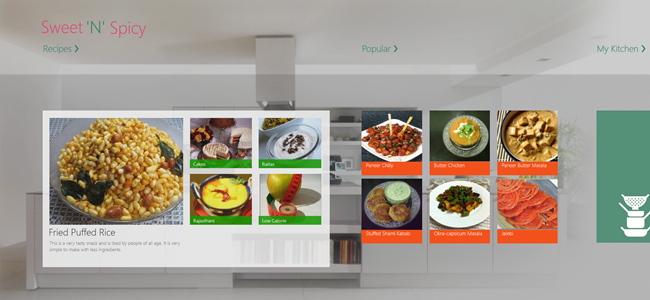
And Tarla Dalal
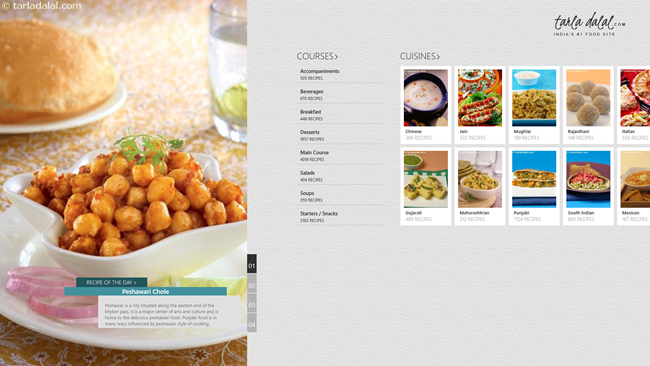
The fact that I absolutely love Indian food played no part in me
picking these two specific apps. Honestly ;) You can find them both
listed in most regions, including the US Windows Store.
Being a tourist
There is a lot to see in India, especially near New Delhi.
I arranged ahead of time to have a driver pick me up at 4am at
the hotel on Saturday with instructions to bring me to the Taj
Mahal and the Red Fort of Agra, and to make sure it was a driver
who could speak and understand English. He then drove me the 4+
hours from Delhi to Agra. Once we arrived in Agra, he picked up my
tour guide for the day (I didn't know I was getting one, but this
turned out to be a good idea). They tried to stop for breakfast at
a place where the guide obviously had some business interests, but
it was too early, I convinced them to skip breakfast and to just
bring me right to the Taj. (I left at 4am, but if taking the
Delhi->Agra highway, I recommend leaving even earlier, like
3:30, depending on traffic etc.)
The Taj Mahal was everything I had hoped it would be, and much
larger. It always looks so small in the photos.
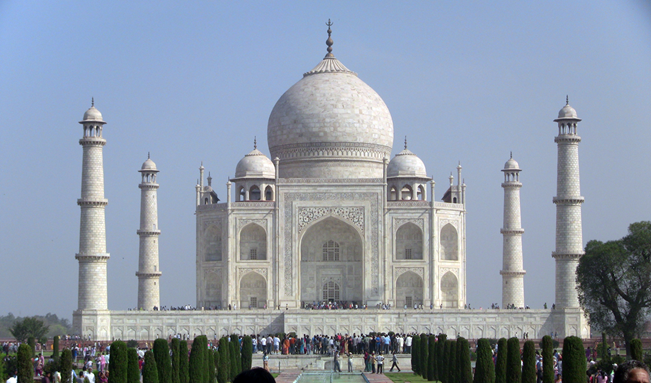
The Taj Mahal is also full of people looking to tap your wallet
a little. Just know it's all part of the experience and keep lots
of rupees on you. The photos, for example, will run you 10,000 to
20,000 rupee. They say it's 100 rupee per photo, but then take
close to 20 of them. Don't worry about whether or not you got the
best price or someone else was able to negotiate off 100 rupee more
than you. These folks are providing a service to tourists and by
western standards, it's pretty inexpensive regardless.
The whole time the tour guide brought me around the Taj, he was
talking up the marble inlay. This is interesting, but understand
it's also them priming the pump for the trip to the state-owned
marble shop afterwards.
TIP
When you're brought to the marble shop, you'll be face to face
with one or more extremely talented sales people. In my case, they
sat me down with hot tea and showed expensive marble tops first,
and afterwards the inexpensive stuff. Then, it was off to jewelry,
and then textiles, and (I insisted they leave this part out) rugs.
In the case of the marble, unless you really want a table top, just
ask to be shown the small things like statues, coasters, etc.
Seriously, these sales people are good. I've had less pressure at a
car dealer.
Some of the marble goods are nice, though, especially at the
state-owned/certified shops. The one I was brought to was an
emporium. I tried negotiating for a bit, but they wouldn't do any
better than a small discount off the top. From speaking with
others, the emporiums are generally fixed price. The one I went to
was Cottage Industries, but oddly it also seems to go by the name
Cauvery Emporium, as I had receipts from both places for my
purchases inside the same building.
Before going in the shop, set a firm budget in your mind, and
convert it to rupees so you don't have to do the math in front of
the sales people. That's the best way to avoid the pressure as you
can firmly say something is outside your budget. Remember, these
folks are good.
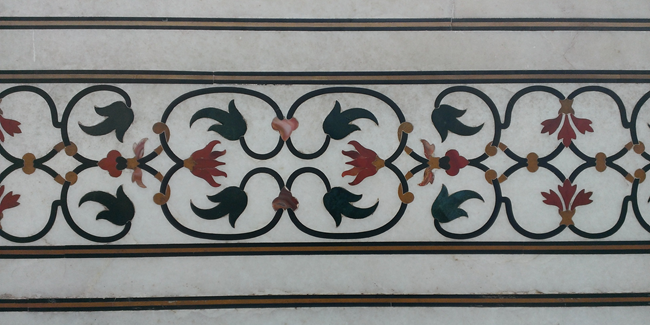
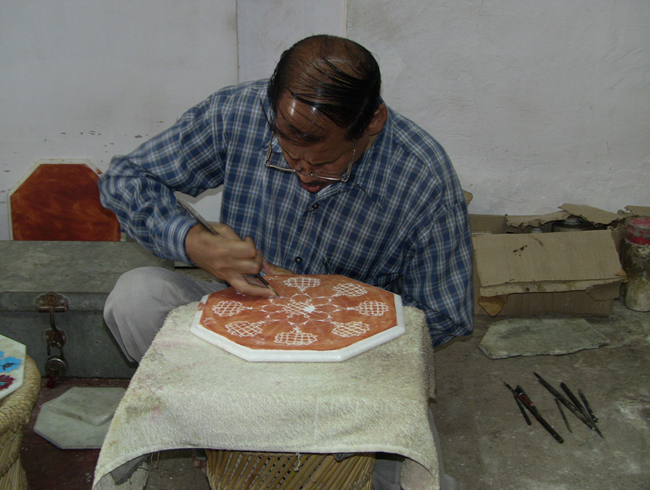
The trip around the Taj Mahal took around 2 1/2 hours. I was
there nice and early, before the majority of the crows. The photo
above was taken on the way out as the place filled up. It was also
getting pretty hot by then.
It also gets pretty hazy as the day goes on. Air pollution is
pretty bad, as is the dust.
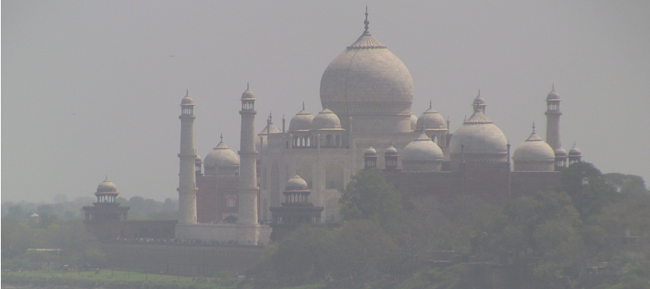
After the trip to the Taj, we stopped for breakfast (extremely
inexpensive compared to the hotels, and very good) and then headed
over to the red fort.
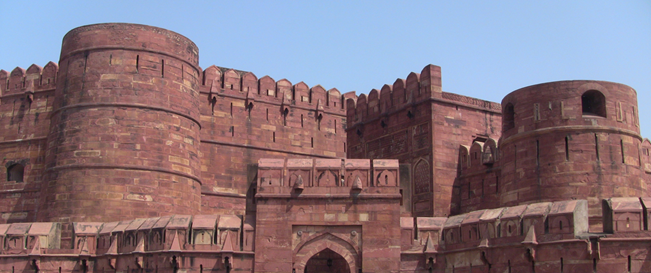
This part of the Agra fort had a fire on the inside, set by
invaders. That burned all the painting off the walls, and left a
smoky colored marble. Note the translucent marble near the
windows.
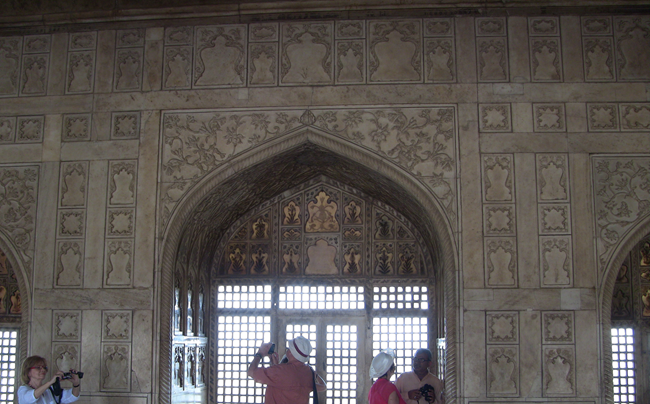
The "forts" in India are the castles. Don't let the name "fort"
put you off, as these aren't US-style forts, and are fully worth
the trip. The Agra Fort, in particular, is impressive both in
construction and in history. Read up a bit on it before
visiting.
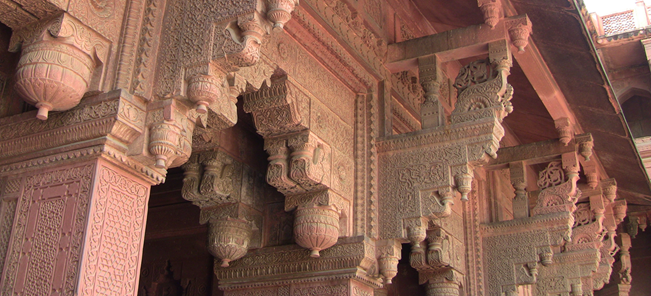
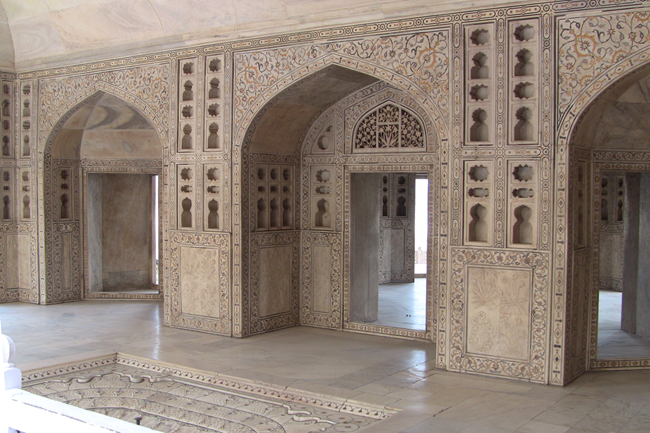
The drive back from Agra took quite a bit longer due to traffic.
It was over 5 hours as I recall. We also had to dodge, of all
things, stray cattle lying in the gutter in Agra. Imagine stray
cats and dogs in another nation and then add like 600-800 pounds.
They were just there, lying down in the street, in the middle of
the city. It was amusing mostly in that it seemed so normal. :)
TIP
Don't get hung up over whether or not you tipped too much for your
tourguide, driver, etc. Tip what you think is fair for the service
you received, and if you go by Western standards, you'll almost
certainly be tipping more than enough. Keep small bills and coins
around for the dude in the bathroom who won't let you out without a
tip.
While in Delhi, I also took an evening tour "Sound and lights
show" of the Delhi Fort. Seeing the Agra Fort afterwards helped complete the
story.
You can
find all of my photos from this trip on my Flickr page.
Poverty
Before I point out a few helpful tips, I wanted to mention the
poverty. I've seen slum-level poverty in the United States, but I
was unprepared for the type of poverty I saw on the outskirts of
the cities in India. Even the Delhi Airport had slum villages right
up against the walls. These villages are made from piles of debris,
trash, old signs, mud, dung and more. Basically, if it can be used
to put a roof over one's head, it will be. I was never able to get
a good photo as cars/planes never stop near the slums. The only
real photos I got were these washed out hazy ones (did I mention
the pollution?) from inside the plane at Mumbai Airport (click for
larger version). These were at least made of building materials.
Many were just hobbit holes in what appeared to be piles of trash
held together by mud along the side of the road.
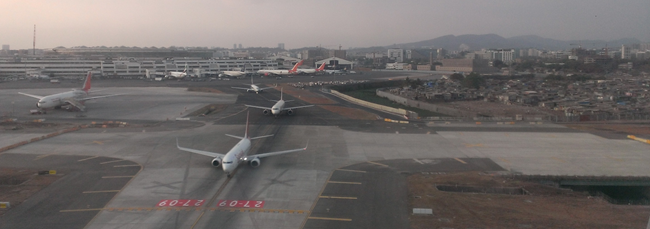

You'll also see a LOT of buildings in various stages of
construction. Many seem abandoned before completion. Many are
concrete skeletons with exposed rebar on top, and bamboo
scaffolding. Such is the nature of a developing country.
Here is an image search showing more of these
slums.
Some advice for fellow westerners visiting India
I've been to a number of places in Europe, but this was my first
time this far east. The culture really is quite different from
European culture, so be prepared.
- Dress
-
- Purchase really light cotton khakis before your visit. I
brought jeans (too hot) and shorts (not recommended, as only kids
wear shorts)
- Women should dress conservatively, especially at monuments. The
Taj Mahal grounds include an active mosque and a lot of local and
short shorts or low tops will likely get you unwanted attention
from folks who think you're being disrespectful or tacky, or from
people who want a closer look.
- Men, if you intend to visit any mosque, arms and legs must be
covered.
- Food
-
- Unlike the US, don't expect to find water/snack vendors all
over the place. If you have Type 1 or other blood sugar control
issues, be sure to carry stuff with you, but also know that Taj
Mahal will not allow most of this in the monument
- If you don't like Indian food, you're really missing out.
:)
- Always drink bottled water. Even in the hotels, stick to
bottled. Avoid salads which have been washed in local water. Even
my India friends who have been away from India for a while found
the local water really upset their stomachs
-
- Brush with bottled water as well.
- Purchasing
-
- If you look western, expect the starting price for everything
on the street to be at least 2-3x what locals would even consider
paying. Negotiate what you can, but also keep in mind that this is
a relatively poor country, and you're doing your part to help out
in a fair exchange of goods and cash. Don't get taken, but don't
worry about nickels and dimes.
- Keep rupees on you. Outside of the western-style hotels, most
places are cash-only. Keep lots of small amounts too, as you'll
find 100 INR is far too large a tip for some things, and too small
for others.
- Use a credit card, not your debit card. You want some
protection.
- Airports and Travel
-
- Airport screenings segregate male / female
- Most airports require that you have a printed boarding pass
before you can even enter the airport. Some will take a PDF on your
phone, but that varies. Web check-in at the hotel.
- Use a hired car and driver. Don't even think of driving
yourself. Hired cars (from a reputable company - I used Car Club)
are very inexpensive. My whole trip to Agra (4am to 8pm) was around
$150 US plus tips. Considering I monopolized a driver from 4am to
8pm, that's pretty good. Trips between hotels and airports
typically ran around $15-$20 USD.
- If you use a video camera, realize that the monuments require
you to pay extra to bring them in, and some like the Taj Mahal,
make you pay to lock them up before entering the monument proper
(they do not allow them on the grounds). I use my video camera as
my still camera, but that didn't matter. Smart phones are fine as
it doesn't seem that Indian officials have caught on to the idea
that smart phones are also video cameras.
- If going on a business trip, make a point of seeing the
monuments close to where you're staying. There are lots of great
things around India, and the beauty can be breathtaking.
